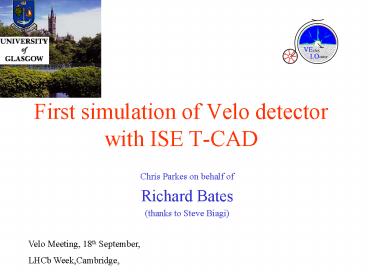First simulation of Velo detector with ISE TCAD PowerPoint PPT Presentation
1 / 15
Title: First simulation of Velo detector with ISE TCAD
1
First simulation of Velo detector with ISE T-CAD
- Chris Parkes on behalf of
- Richard Bates
- (thanks to Steve Biagi)
Velo Meeting, 18th September, LHCb
Week,Cambridge,
2
Contents
- Aims
- Device under investigation
- Simulation details
- MESH
- MIP definition
- Results
- Charge density drift plots
- Signal
- A long To do list
3
Use powerful fully functional 3D semiconductor
simulation package to simulate-
- Electrically static Velo detectors
- Guard ring structures
- Strip metal overhangs to limit high field regions
- Transient response of devices
- Signal lost to routing lines in irradiated
detector - Floating strips
- change in resolution
- spread of signal (negative signals)
4
Simulated a 2D cross-section of F detector
390V Curvature due to limited size
- p-on-n 200µm thick Micron device
- Implants 16.8µm
- Pitch 55.5µm
- Routing lines 17µm
- To do x/sections at different Pitch
Electric Potential in device
5
Detail of AC coupling
- 150nm SiO decoupling layer
- 3.8µm SiO insulating layer
- Equivalent 1MO bias resistor
n-Si bulk
p-strips
SiO
Al strips
Al routing lines
6
Extract static variables
- Potential (V) E-field (V/cm) through device
Note large E-field in 150nm thick AC oxide
thin oxide
bulk
Al contact
strip
7
Transient simulation -The MESH
- Mesh definition very important
- controls initial charge deposited
- defines charge cloud
- Good Mesh adds accuracy with excessive CPU time
Very dense where MIP generated Fine at extremes
of device
8
MIP well defined
- Used a Gaussian charge cloud
- s 1µm
- linear energy transfer 3.14e13pairs/cm3
- 80e/h pairs/µm
- Simulation deposited charge correctly (within
10) simple device collects everything
Cross section of e/h pairs generated
9
Charge drifts under E-field Holes 100V
2ns
2.5ns
2.2ns
5ns
10ns
20ns
10
Electrons 100V
2ns
2.5ns
2.2ns
11
Holes 300V
2ns
2.5ns
2.2ns
5ns
10ns
20ns
12
Electrons 300V
2ns
2.5ns
2.2ns
5ns
10ns
20ns
13
Signal collected from AC detector
- Can differentiate signal due to electrons and
holes - Signal collected under 4 bias conditions 100,
200, 300, 390V - Total Collection time falls (ccegt98) 40ns?15ns
Electron signal seen at strips
14
Charge sharing
- For 390V
- Over depleted, no traps, no radiation
- Signal seen
- Signal strip 99.3
- Nearest neighbour 0.3
Signals for 100,200,300,390V on signal strip, 1
and 2 strips
15
To Do
- Charge sharing to routing lines
- very close to a result
- under-deplete device in inversion
- Addition of traps?
- Re-run for different
- strip widths/pitch
- oxide thickness
- Straight forward extension to other problems
- floating strips
- guard ring structures
- strip metal overhangs
- But a lot of work!

